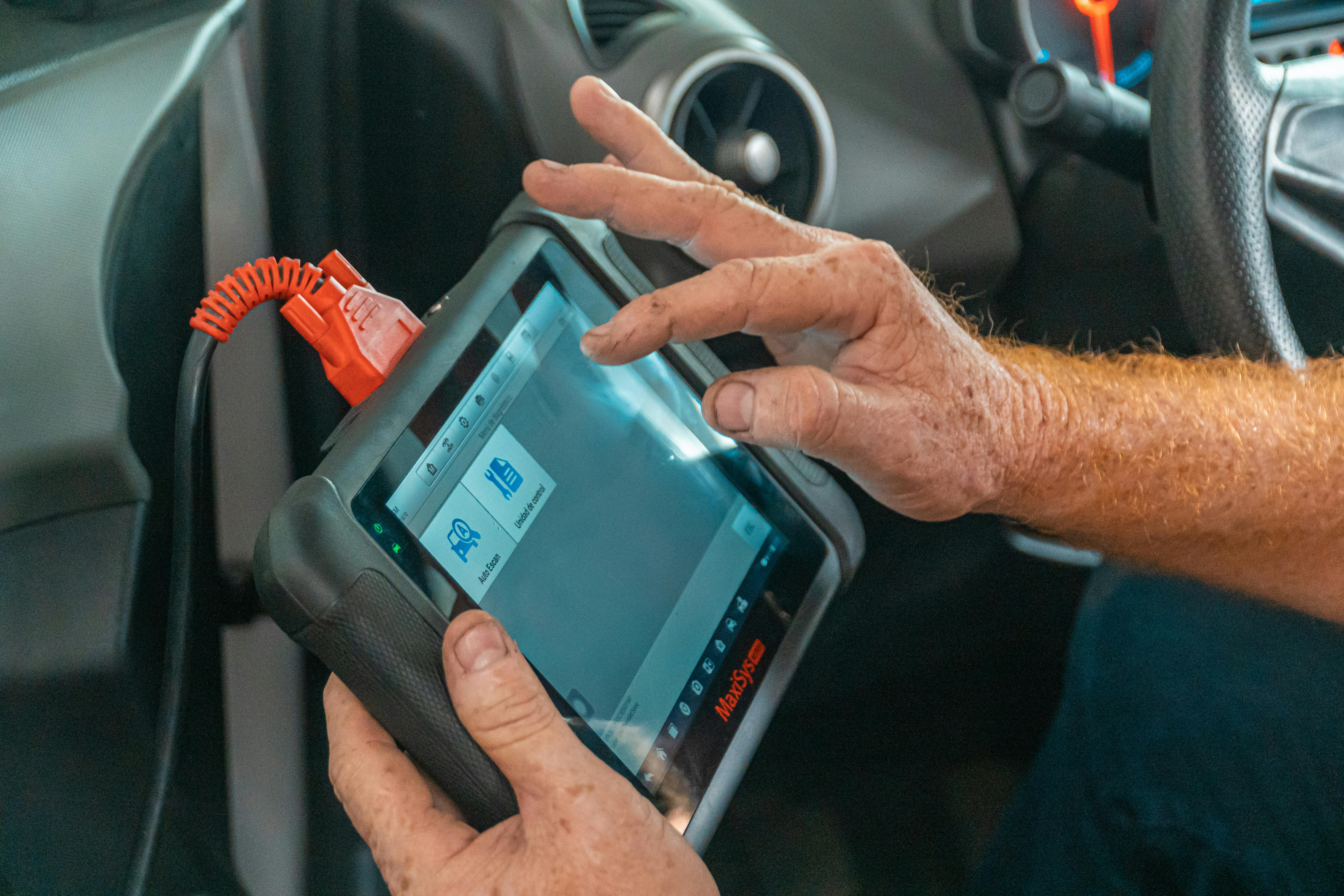
How Truck Diagnostic Tools Are Revolutionizing Heavy-Duty Repairs

Key Takeaways
-
State-of-the-art truck diagnostic tools are instrumental in minimizing repairs’ downtimes, maximizing workshop efficiency, and ensuring vehicles perform at their best. Investing in smart, advanced tools means you’re saving time and money while automatically generating the reliability that counts.
-
Leverage robust hardware features and advanced software applications to enable rapid and precise fault detection. Innovations such as wireless connectivity and cloud integration add more convenience, allowing for faster diagnostics and easier data access.
-
Better diagnostic capability leads to fewer costly parts replacements and repair jobs that aren’t needed, cutting overall repair costs sharply. Proactive maintenance strategies, both made possible and supported by advancements in diagnostics, telematics, and other tools, prevent those expensive breakdowns.
-
Powerful key functions like real-time monitoring, bi-directional control, and automated reporting are all integral for proper diagnostics. Safety-enhancing features increase technician productivity and transparency with customers.
-
Interpreting the specifications of diagnostic tools I can’t overstate this enough. Think about processor speed, memory capacity, and overall durability in selecting tools that can support your operations and stand up to industrial-intense environments.
-
Frequent software updates and rigorous data security measures ensure that diagnostic tools are always effective. By focusing on compatibility across all vehicle models, you’re ensuring their long-term reuse.
Truck diagnostic tools allow the user to quickly and accurately identify, troubleshoot, and fix vehicle issues for effective fleet maintenance and repair. Note that these tools plug directly into the truck’s onboard systems. They provide data about their engine performance, transmission, fuel systems, and so on — all in real-time.
Made for professionals who demand only the very best, these time-saving tools help you find the most accurate diagnosis while eliminating costly repair guesswork. More sophisticated models include amenities such as wireless pairing capabilities. They’re compatible with a wide range of truck brands, which makes them versatile tools for any professional or fleet manager.
Whether you’re maintaining a single truck or managing a fleet, they are indispensable tools. They power your business with confidence and allow you to pay less from avoidable downtime. In the following sections, we’ll explore key features, benefits, and tips for choosing the right diagnostic tool for your needs.
Why Modern Truck Diagnostics Matter?
In a bustling, high-stakes, often hectic industry like today’s trucking, innovative diagnostic tools are essential. They make greater reliability, less expense, and more efficient operations all possible. These innovations can have a profound benefit by poising fleets to fix problems quickly and accurately the first time, resulting in improved vehicle uptime and increased operational efficiency.
Improve Repair Efficiency
Modern diagnostic tools cut through the complexity to save time and streamline workflows by finding the right problem the first time. For instance, advanced scanners like the Ancel X7HD allow technicians to pinpoint problems in minutes, reducing the reliance on trial-and-error troubleshooting. This level of precision saves valuable time and helps prioritize which repairs will be the most effective.
We help you avoid replacing perfectly good parts unnecessarily. Our equipment identifies the real reason for the malfunction, focusing on the primary cause instead of just treating the symptoms. That kind of efficiency is what gets trucks back on the road faster and minimizes expensive downtime.
Enhance Diagnostic Accuracy
With advanced software and real-time data, these tools are best-in-class at helping you find the right fault detection. Through the power of telematics and IoT, diagnostics have evolved to give technicians crystal clear, actionable insight, even down to complicated systems.
For one, OEM-approved data means repair procedures are the most reliable, effective and safe. That level of accuracy eliminates repeat problems since the actual cause is handled at the source. Advanced tools allow prioritized fault codes to be interpreted via telematics, allowing fleets to take immediate action and keep their trucks moving—maximizing productivity.
Reduce Overall Repair Costs
Reliable diagnostics significantly reduce repair costs by reducing hours in labor and parts not needed. Avoid future breakdowns. Early detection of small, non-critical malfunctions stops them from turning into big problems down the line.
In the case of heavy-duty trucks, unplanned downtime can result in hundreds of dollars per day. Proactive, predictive maintenance strategies, enabled with advanced equipment through solutions such as the Ancel X7HD, help reduce these risks and protect your equipment and budget.
What Defines Modern Diagnostic Tools?
Modern truck diagnostic tools have redefined how we approach vehicle maintenance by blending cutting-edge hardware, sophisticated software, and seamless connectivity. Unlike preceding technologies, these tools are intended to deliver fast, accurate, and consistent diagnostics that are intuitive and adaptable.
By leveraging advanced capabilities such as real-time monitoring, telematics, and IoT, they provide full visibility into the health of your trucks. Here are the four primary areas that distinguish these modern diagnostic tools.
Advanced Hardware Components
At the heart of state-of-the-art diagnostic tools are high-performance processors that dramatically accelerate the troubleshooting process. These processors allow for intense calculations that give the ability to quickly identify a fault condition in a complex system such as a diesel engine or electrical system.
A rugged construction holds up against severe shop environments – extreme heat or cold, abusive physical conditions. Thirdly, multi-channel support is an essential feature, enabling the diagnostics of multiple systems at once, which saves time and increases productivity.
For example, a diagnostic tool that could simultaneously investigate transmission and engine performance could cut downtime in half.
Sophisticated Software Capabilities
Advanced diagnostic software comes with new functionality like automated fault detection and proactive maintenance alerts. We issue periodic updates to stay current with changing truck models.
This allows for improved diagnostic precision and allows us to keep a fault detection success rate greater than 90%. Comprehensive databases provide detailed insights into various vehicle systems, from American to European trucks, offering actionable solutions tailored to specific manufacturers.
Wireless Connectivity and Integration
Having diagnostics featured wirelessly would give technicians the support they need without being physically connected. The integration with telematics systems supports real-time vehicle monitoring, while cloud-based platforms simplify data storage and access.
This ensures fleet managers stay informed anytime, anywhere.
How Do Modern Diagnostic Tools Improve Truck Repair?

With the introduction of new modern diagnostic tools, truck repair has been entirely redefined from manual, trial-and-error techniques to a highly analytical and data-driven process. Through implementation of highly developed cutting-edge technology, efficient, effective, accurate, diagnostic tools strengthen the capabilities utilized to identify and resolve vehicle issues.
Here, we take a look at how these innovations are influencing the industry.
1. Pinpoint Faults Accurately
Today’s modern diagnostic tools benefit from robust algorithms that enable technicians to pinpoint specific issues in a matter of minutes. Take OBD scanners as an example; when used as part of a vehicle’s onboard diagnostics, they read diagnostic trouble codes (DTCs), pinpointing specific areas of concern and the needed repairs.
This takes all of the guesswork out of the equation, allowing for precise fault detection and significantly less repair time. With precise diagnostics, technicians can focus on addressing the root cause of problems, improving customer satisfaction through reliable and timely repairs.
2. Access Comprehensive Vehicle Data
These new tools utilize powerful, national vehicle databases combined with real-time data coming in from sophisticated vehicle sensors and electronic control units (ECUs). Data storytelling technicians are able to learn about the complete picture of a truck’s operation and performance, including fuel efficiency measures and advanced safety systems.
Having access to such insights allows workshops to make evidence-based decisions that ensure service quality standards remain at the highest level, all while tackling the more difficult problems with confidence.
3. Streamline Repair Processes
With the use of defined diagnostic practices, repair operations are markedly improved. Automated diagnostics eliminate unnecessary manual steps, speeding up the processes of detecting faults and their associated repairs.
For example, advanced truck transmission diagnostic systems monitor and evaluate key parameters such as fluid pressure and gear engagement, leading to faster resolutions and reduced downtime.
4. Enable Remote Diagnostics
With telematics and remote access, technicians can start tracking vehicle health and performance long before they need to be on-site. This capability improves response times for fleet maintenance and adds flexibility by diagnosing trucks in different locations, keeping operations seamless.
5. Support Predictive Maintenance
Predictive technological solutions use data trends to predict upcoming failures and let shops address them with proactive maintenance. By preventing unexpected breakdowns with real-time condition monitoring, lifecycle accelerators help trucks run at peak performance for longer periods of time.
Key Features of Heavy-Duty Diagnostic Tools
Heavy-duty diagnostic tools are essential for servicing and repairing today’s complex commercial vehicles. These tools are up to the unique tasks that heavy-duty trucks require. They balance cutting-edge innovation with real-world utility, empowering technicians to do their best work faster and more accurately.
Below, we outline the key features that make these tools indispensable.
Real-Time Data Monitoring
One of the most important functions of heavy-duty diagnostic tools is the ability to monitor real-time data. This capability is helping technicians identify potential problems before they begin. They can help identify things like overheating or abnormal fuel usage before those become expensive repairs.
For instance, monitoring live data can diagnose clogged Diesel Particulate Filters (DPF) so your technicians can take immediate action such as performing a forced regen. This capability helps keep vehicles and communities running smoothly without increasing expensive downtime.
Bi-Directional Control Functions
We went hands-on. The bi-directional control feature makes it possible to directly interact with vehicle systems. Technicians can even create test execution, component adjustment, and system calibration sequences without any manual steps.
For example, it allows injector code replacement and VGT calibration. By providing dealer-level diagnostics, these tools help make complex repairs more straightforward and help troubleshoot the time-consuming issues faster.
Parameter Programming
Parameter programming lets you customize vehicle settings to match operational needs. Adjusting engine parameters, such as idle speed or fuel flow, improves performance and efficiency.
This feature is especially valuable for mixed fleets, as it supports various engine models, including Cummins X15 and Volvo, with precise programming capabilities.
Automated Reporting
Automated reporting makes it easy to maintain your records by automatically creating detailed diagnostic histories and health summaries. These reports provide maintenance information, fault code corrections and system calibrations which allow the technician to give a clear account of work done to the customer.
Frequent reporting improves fleet management too, by having data to look at long-term vehicle performance patterns.
Explore Diagnostic Tool Specifications

The biggest part of selecting the right truck diagnostic tools comes down to doing your homework. Specifications directly influence the tool’s performance, usability, and lifespan, ensuring it meets the demands of diagnosing and maintaining complex truck systems like US07, US10, or US13 model Mack engines.
In a close look at diagnostic tool specifications, one can easily find that the tool can report vehicle temperature, battery health and state of charge gauges. It powers up higher-end features such as bi-directional controls and fault code management.
Processor and Memory Requirements
Well designed robust hardware is a prerequisite for effective diagnostics. Minimum recommended specifications include a diagnostic tool with at least a Xeon i5 processor and 8GB of RAM. This configuration is included by default in the Universal Kit.
This setup runs memory-intensive applications such as Diesel Explorer for advanced software analysis. It simplifies complex things like engine data PDF reporting, resetting learned data and trip analysis.
That’s why memory is very important for devices such as USB-Link 3 VCIs. They’re loaded with expanded random access memory, empowering them to process dozens of data channels at once with precision.
Inadequate hardware can make loading possibilities cumbersome, limiting the flexibility and responsiveness the tool provides, and making it harder to use effectively.
Display and Interface Qualities
For streamlined operations, diagnostic tools require high-resolution displays and user-friendly interfaces. Larger touchscreens greatly increase levels of interaction.
They simplify the process of using advanced features like manual diesel particulate filter regeneration and injector cut-out tests. Large, bright, high-contrast screens are essential to readability in even the most sun-filled shop environments, making certain technicians have instant access to the most important job information.
Durability and Environmental Resistance
In harsh shop conditions, known as live job site conditions, tools can be subject to dust, moisture and hard impact. Durable, smart builds maximize longevity, and environmental resistance makes sure tools like Diesel Repair Standard stay reliable in the field of heavy-duty wear and tear.
Essential Functions of Diagnostic Tools
Diagnostic tools are an essential piece of today’s vehicle maintenance and repair operations, with sophisticated technology that helps technicians find and fix problems right the first time. Their essential functions make the diagnostic process faster and more accurate. This helps technicians, as well as fleet managers, keep vehicles healthy without additional effort on their part.
Read and Clear Diagnostic Trouble Codes
Reading and clearing diagnostic trouble codes (DTCs) is the most basic function expected. These codes are created by the vehicle’s onboard systems. Technicians rely on them to easily find faults such as a faulty sensor or emission failures.
Clearing codes after any repair ensures the system is reset and the new repair can be double checked against resolving the code. For example, OBD scanners can display codes related to transmission faults or battery performance, guiding targeted repairs and saving time.
Monitor Live Engine Parameters
Live monitoring gives real-time insights into an engine’s performance by tracking key parameters such as RPM, fuel injection, and temperature. This constant monitoring means that things can be caught early, like overheating or weird fuel delivery.
Diesel engine diagnostic kits are best suited to analyzing high pressure fuel systems and emissions controls. Their work keeps diesel vehicles running at top performance.
Perform Component Testing
Component testing removes faults by testing single systems such as alternators or ignition coils. Oscilloscopes, for example, are used to visualize signal waveforms for diagnosing a sensor problem.
Multimeters measure the electrical outputs on a vehicle to isolate a wiring flaw. Correct component identification makes way for correct repair the first time around, saving time and money on costly callbacks and repairs.
Generate Vehicle Health Reports
Comprehensive health reports provide a complete summary of diagnostic findings for customers, offering insights about repair recommendations. These reports encourage accountability and honesty.
When combined with vehicle-specific diagnostics such as TSBs (technical service bulletins) or recall notices, they provide the information you need to make maintenance decisions with confidence.
Benefits of Real-Time Data Analysis
The ability to analyze data in real-time has completely changed the scope of fleet management, providing actionable insights even while data is still being created. By harnessing the power of this technology, fleet managers are able to stay one easy step ahead of the competition. This helps in keeping their vehicles efficient, reliable, and cost-effective.
Identify Performance Issues Early
Being able to identify performance issues in real-time means potentially expensive breakdowns can mostly be avoided. Getting early warning of engine discrepancies or unusual idling can save costly damage. With timely detection, maintenance can be scheduled before minor issues become major problems, ultimately enhancing fleet reliability.
Insights gained from real-time monitoring of DPF (diesel particulate filter) soot levels, for example, stop emissions systems from working too hard. This prevents unnecessary downtime and wear. Over time, tracking historical data can reveal recurring patterns, helping identify long-term performance challenges that may otherwise go unnoticed.
Optimize Fuel Efficiency
Fuel consumption is the second biggest operational cost for truck fleets. With thorough analysis of data captured through telematics systems, industry-specific insights can be gained. These insights include the impact of driving behavior, route inefficiencies, and excessive idling.
Implementing data-driven changes, whether they require route optimization or driving style training, can have a transformative impact on fuel efficiency. Even small improvements across a fleet can lead to significant savings in a year. By improving fuel management and taking a more proactive approach, companies can save money while also helping achieve sustainability goals.
Prevent Costly Breakdowns
Predictive analytics have become essential in helping to avoid costly breakdowns. By analyzing data trends in real-time, we can forecast where failures are likely to occur and schedule maintenance at the optimal moment. This offers the obvious benefit of saving repair costs, but it also reduces downtime, returning vehicles to the road more quickly.
Improved uptime and asset utilization keep fleets moving and their assets productive. This contributes positively to the bottom line for years to come.
Addressing Diagnostic System Challenges
In truck diagnostics, such challenges are typically presented by the increasing complexity of today’s vehicles and their rapidly changing technology. Effective diagnostics require not just tools but strategies to handle these challenges efficiently.
Software Update Management
Continuously setting standards and keeping these diagnostic tools updated is necessary to ensure those standards are accurate and considered reliable. Frequent updates ensure that the software remains compatible with the newest vehicle makes and models. This is important for supporting changing truck standards such as J1587 or J1939.
An ineffective tool can lead to failing to diagnose a high-pressure fuel system fault on a diesel engine. This lack of oversight may lead to unnecessary extended downtime. Simplifying the update process, for example by scheduling updates during off-peak hours, reduces the impact on operations.
Automated systems proactively alert technicians when someone drops new content on their system. This eliminates the need for time-consuming manual tracking, while providing guaranteed availability of tools when needed.
Data Security Protocols
With new diagnostic tools able to access sensitive vehicle and customer data, solid security templates are indispensable. Technologies such as encryption and multi-factor authentication defend this sensitive information and uphold the implicit contract of trust between service providers and their clients.
For example, fleet managers using telematics for real-time monitoring must ensure data transmitted from trucks is secure to prevent breaches. Beyond the negative fiscal impact that a single data breach can bring, it is damaging to an organization’s reputation.
This perspective only underscores the urgent need to build in robust cybersecurity protections.
Ensuring Compatibility Across Models
The challenge that we face is that trucks are incredibly heterogeneous in make and model, everything from 18 wheelers to smaller delivery vehicles. Diagnostic tools need to be able to support this diversity.
Flexible solutions that can accommodate a J1708 and OBD-II system, for example, provide confidence that they will work seamlessly with both legacy and current technology. This flexibility reduces the overall need for various tools.
In addition to improving diagnostic efficacy, it increases operational efficiency, especially within mixed operations using remote and/or automated vehicle diagnostic systems.
New Age Motors: Your Diagnostic Partner
At New Age Motors, we believe that vehicle diagnostics should be an industry-leading experience. Services provide unwavering integrity, state-of-the-art diagnostic tools, and world-class service. Since expanding from New Age Oilfield Services in 2019, we’ve carried forward core values like customer service and safety while embracing cutting-edge technology to meet modern demands.
This philosophy has made us a diagnostic partner with commercial fleets and private vehicle owners identical.
Cutting-Edge Diagnostic Systems
Our Jaltest Freightliner diagnostic system represents the forefront of technology, offering professional dealer-level solutions for Freightliner trucks, particularly the Cascadia model. This system accurately identifies issues, including front radar sensor checks in anti-collision systems, ensuring precise fault detection.
By using such advanced tools, we improve service quality, reduce guesswork, and streamline repairs, saving your time and resources. Whether diagnosing Cummins engines or tackling commercial equipment, our tools ensure unmatched accuracy for diverse vehicle types.
Fast and Reliable Service
Better diagnostics = Faster turnaround times = More vehicles on the road with less downtime. For commercial fleets, this efficiency is the lifeblood of their operations. Our team’s commitment to providing timely repairs of your passenger vehicles and fleet, along with a service guarantee, shows our devotion to reliability.
This not only makes sure your customers are happy, but builds their trust over the long term.
Expertise in Commercial Fleet Vehicles
Our technicians have proven experience working on fleet vehicles, from heavy construction vehicles to material handling equipment. Their wealth of expertise promises knit diagnostic solutions tailored to commercial needs, pristine and ready to roll.
Fuel pump diagnostics backed by decades of experience, we’re equipped to tackle any model and challenge.
Conclusion
Today’s truck diagnostic tools are making a big difference in the approach we take toward heavy-duty vehicle repairs. They offer increased speed of diagnosis, increased diagnostic accuracy, and over-the-air updates, which keep trucks on the road longer and safer. Choose the correct equipment to perform more than just basic scans. Access complex features that make maintenance easier and increase productivity.
Picking a proven partner such as New Age Motors will ensure that you have diagnostic tools developed to handle the practical needs of today. From sophisticated analytics to intuitive displays, these tools are engineered to meet the challenges faced by today’s trucking fleet.
Investing in the right productivity diagnostic tool will increase your shop’s productivity and save you time, money and stress. Find out how to get started today and discover the impact a more intelligent approach can have.
Frequently Asked Questions
What are truck diagnostic tools used for?
Truck diagnostic tools allow users to quickly identify and troubleshoot issues in heavy-duty vehicles. They plug directly into the truck’s onboard diagnostic systems. This enables them to access real-time data, error codes, and performance insights, facilitating accurate diagnostics and efficient repairs.
Why are modern truck diagnostic tools important?
Today’s high-tech tools come with powerful features such as real-time data analysis and pin-point error detection. They’re a necessary step to save time on repairs, repair costs and overall vehicle maintenance efficiencies which are vital to keeping heavy-duty trucks in operation.
What features should I look for in a diagnostic tool?
Look for things like wide compatibility across truck brands, real-time data analysis, wireless functionality, and in-depth error code descriptions just for starters. Together, these features deliver smarter diagnostics and more efficient repairs.
How do diagnostic tools improve truck repair?
Diagnostic tools help technicians identify issues quickly and accurately. This not only saves time but reduces repair time, resulting in less downtime and your truck back on the road quicker.
Can I use a diagnostic tool without professional training?
Certain commercial tools are easy to use, being specifically tailored for novices. Though sophisticated tools, you may need some level of training or automotive expertise to interpret data correctly and perform proper diagnostics.
What are the benefits of real-time data analysis in diagnostics?
Real-time data analysis is one of the most powerful aspects of connected truck solutions. This allows them to catch problems earlier, avoid expensive breakdowns, and maximize their trucks’ performance more effectively.
How does New Age Motors support truck diagnostics?
New Age Motors offers the assistance of veteran mechanics and the use of cutting-edge diagnostic equipment. They make certain you receive the ideal diagnostic tools while providing you with professional support and time-tested expertise you can trust.
Explore The Full Range of Services Offered By New Age Motors:
Read Further on Vehicle Safety and Standards
Alberta Motor Vehicle Industry Council



